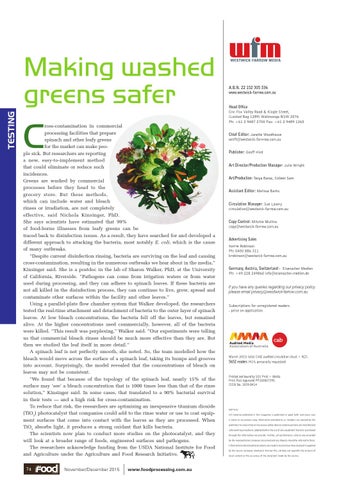TESTING
Making washed greens safer
C
ross-contamination in commercial processing facilities that prepare spinach and other leafy greens for the market can make people sick. But researchers are reporting a new, easy-to-implement method that could eliminate or reduce such incidences. Greens are washed by commercial processes before they head to the grocery store. But these methods, which can include water and bleach rinses or irradiation, are not completely effective, said Nichola Kinsinger, PhD. She says scientists have estimated that 99% of food-borne illnesses from leafy greens can be traced back to disinfection issues. As a result, they have searched for and developed a different approach to attacking the bacteria, most notably E. coli, which is the cause of many outbreaks. “Despite current disinfection rinsing, bacteria are surviving on the leaf and causing cross-contamination, resulting in the numerous outbreaks we hear about in the media,” Kinsinger said. She is a postdoc in the lab of Sharon Walker, PhD, at the University of California, Riverside. “Pathogens can come from irrigation waters or from water used during processing, and they can adhere to spinach leaves. If these bacteria are not all killed in the disinfection process, they can continue to live, grow, spread and contaminate other surfaces within the facility and other leaves.” Using a parallel-plate flow chamber system that Walker developed, the researchers tested the real-time attachment and detachment of bacteria to the outer layer of spinach leaves. At low bleach concentrations, the bacteria fell off the leaves, but remained alive. At the higher concentrations used commercially, however, all of the bacteria were killed. “This result was perplexing,” Walker said. “Our experiments were telling us that commercial bleach rinses should be much more effective than they are. But then we studied the leaf itself in more detail.” A spinach leaf is not perfectly smooth, she noted. So, the team modelled how the bleach would move across the surface of a spinach leaf, taking its bumps and grooves into account. Surprisingly, the model revealed that the concentrations of bleach on leaves may not be consistent. “We found that because of the topology of the spinach leaf, nearly 15% of the surface may ‘see’ a bleach concentration that is 1000 times less than that of the rinse solution,” Kinsinger said. In some cases, that translated to a 90% bacterial survival in their tests — and a high risk for cross-contamination. To reduce that risk, the researchers are optimising an inexpensive titanium dioxide (TiO2) photocatalyst that companies could add to the rinse water or use to coat equipment surfaces that come into contact with the leaves as they are processed. When TiO2 absorbs light, it produces a strong oxidant that kills bacteria. The scientists now plan to conduct more studies on the photocatalyst, and they will look at a broader range of foods, engineered surfaces and pathogens. The researchers acknowledge funding from the USDA National Institute for Food and Agriculture under the Agriculture and Food Research Initiative. 74
November/December 2015
www.foodprocessing.com.au
A.B.N. 22 152 305 336 www.westwick-farrow.com.au Head Office Cnr. Fox Valley Road & Kiogle Street, (Locked Bag 1289) Wahroonga NSW 2076 Ph: +61 2 9487 2700 Fax: +61 2 9489 1265 Chief Editor: Janette Woodhouse wnift@westwick-farrrow.com.au Publisher: Geoff Hird Art Director/Production Manager: Julie Wright Art/Production: Tanya Barac, Colleen Sam Assistant Editor: Melissa Barks Circulation Manager: Sue Lavery circulation@westwick-farrow.com.au Copy Control: Mitchie Mullins copy@westwick-farrow.com.au Advertising Sales Kerrie Robinson Ph: 0400 886 311 krobinson@westwick-farrow.com.au Germany, Austria, Switzerland - Eisenacher Medien Ph: +49 228 249860 info@eisenacher-medien.de If you have any queries regarding our privacy policy please email privacy@westwick-farrow.com.au
Subscriptions for unregistered readers - price on application
March 2015 total CAB audited circulation (Aust + NZ): 5652 readers (91% personally requested)
Printed and bound by SOS Print + Media Print Post Approved PP100007395 ISSN No. 1039-8414
NOTICE: All material published in this magazine is published in good faith and every care is taken to accurately relay information provided to us. Readers are advised by the publishers to ensure that all necessary safety devices and precautions are installed and safe working procedures adopted before the use of any equipment found or purchased through the information we provide. Further, all performance criteria was provided by the representative company concerned and any dispute should be referred to them. Information indicating that products are made in Australia or New Zealand is supplied by the source company. Westwick-Farrow Pty Ltd does not quantify the amount of local content or the accuracy of the statement made by the source.
